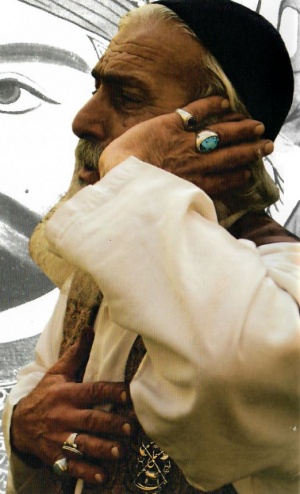Hassan mirza ali
Hassan Mirza Ali (born in 1946) is a prominent Pardekhan and Ta’ziyakhan. Morshed Mirza Ali is quick and agile in movements, his speech causes quickness in motion and leads to the appearance of epic performance. Years of reciting sung-plays (Ta'ziya) has increased his ability in curtain-storytelling and his performance is influenced by this genre of sung-playing. The connection with the audience, control and self-confidence, powers of improvisation in the needed correspondences relating to contemporary subjects, and faith in the truth of the told stories are his other particularities.
Hassan mirza ali | |
|---|---|
 | |
| Born | 1946 Tehran |
| Nationality | Iranian |
| Known for | Pardekhani and Ta'ziyekhani |
| Patron(s) | Haj Taqi Mirza Ali (his father-Grandson of Haj Reza Mirza Ali) |
Performance MethodEdit
Hassan Mirza Ali has reached the status of Morshed (acknowledged master) [1] in Curtain-Storytelling [2] speech and motion. His performance has the following characteristics:
- Having a thorough knowledge of stories based on the illustrated curtains
- Having of the linguistic terms in the sections of the prologue, Monajat (rogation), Khutba (sermon), Manaqib (Praise), lamentation, tangent, story and prayer) [3]
- Having of the traditional and known (figures, fixed and mobile) of picture- storytelling.
-Having of the historical, political and ethical particularities of the characters in the curtains (protagonists and antagonists)
- Performance of various roles following the rules of patterns (figure and intonation) and changing of roles.
Reciting MethodEdit
Morshed Mirza Ali due to his familiarity with a great many sung play (Ta'ziya) melodies is very successful in curtain-storytelling. For example, in this song series, he begins with the intervals of the prelude (Daramad [4] / Pishdong) [5] of Mahuro. [6] This happens while the melody modulation is not corresponded with what we know as the Mahur acoustic space.
NarrationEdit
Nezameddin Qasab with his wife and children are followers of Imam Ali and each time, they bring the name of Ali to their lips the oppressive government bothers them. The ruler becomes seriously ill and his physicians deem the blood of the faithful Shi'ite Ali to be the one and only cure. In the meanwhile, Imam Ali is guest of Nezameddin, the son of Nezameddin martyrs himself so his father could host his guests. The son with head cut off is miraculously brought back to life by Imam Ali.
SourceEdit
- Ardalan, hamidreza (2008). Picture-storyteller masters of iran, the Iranian academy of the art, 2008, volume 17. ISBN: 978-964-2986-040(vol.17). 978-964-2986-002(set).
ReferencesEdit
- ↑ Morshed: distinguished master in curtain-storytelling.
- ↑ Pardekhani: Kind of traditional theatre based on the picture narration.
- ↑ Monajat, Khotbe, Manqabat and story: parts of Pardekhani.
- ↑ Daramad (prelude)-the name of the introductory melody or melodies of Iranian traditional music.
- ↑ The basis of Iranian music mode are composed of a number of linked tetrachord. The most important note in each Gushe known as the Shahed note constitutes the beginning point of the first tetrachord. Also the notes preceding the Shahed note which can make up a tetrachord or pentatonic are termed Pishdong.
- ↑ The Iranian music modes (Dastgah) are made up of a continuous series of six tetrachorder Dongs . Concentrating on one Dong and emphasis on a certain note leads to the change in function of the notes. The two initial Dongs, Pishdong and the first Dongs, in each Dastgah in which the Daramad is performed, yield the main concept of the Dastgah.